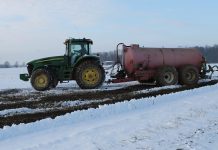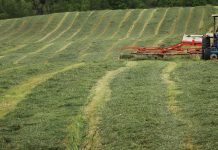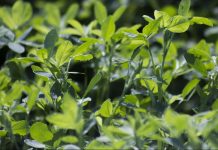This summer I had numerous landowners stop in our office asking for information on how to grow chestnut trees from seed. Many of these landowners were going to gather seeds from other mature trees on their property and were not sure what to do next.
Options
One option is to plant the seeds outside as soon as they drop, but this option gives you less control over the growing seeds.
The other option is to store the seeds and then grow them indoors. This allows you to plant seedlings the following spring. With this option there is less chance of the seeds being killed due to extreme weather or being eaten by rodents, as well as other animals.
In this article I will discuss the second option, as it allows the landowner to have a little more control over the growing seeds.
Chestnut seeds or nuts are produced from the female flowers of the tree. Some of the female flowers develop into prickly fruits that contain the chestnut seeds. These fruits have a spiny husk that will split open in the fall and release several nuts that are flattened on at least one side.
Gathering
Seeds can be picked up off the ground or harvested in early October by cutting the fruit off the tree and then storing it in a cool place until the husk splits. Once the chestnuts are free from the husk, they should immediately be placed in a plastic bag or bucket with holes and filled with moist peat moss. Each nut should be completely surrounded with peat moss and should not touch the side of the container or other nuts.
The nuts can then be stored in a refrigerator with a temperature of 32-34 degrees Fahrenheit for two to three years. The chestnuts will require a minimum of two to three months of cold before they will germinate.
After cold storage the chestnuts can be planted indoors around February and March. Seeds should be placed on a warm, sunny window sill or in a greenhouse with a temperature of 70-80 degrees Fahrenheit.
Two quart cardboard milk cartons with the bottoms cut out make good pots. The bottoms of the cartons can be covered with window screen or hardware cloth to keep the potting mix from falling out and allow sufficient root aeration.
Planting
Chestnuts have a tendency to rot in compacted soils, so a growing medium with plenty of fibrous materials is a good choice. Soil-less potting mixes with lots of composted bark is a good option. These mixes provide plenty of aeration and help preserve the root ball when it is time to transplant the seedlings.
The nuts should be planted one half inch to 1 inch deep, with the flat side facing down. Make sure to keep the soil moist, not wet and occasionally add a dilute solution of complete fertilizer.
The seedlings should be ready to transplant mid-May after the last dangerous frost. Before transplanting, it’s a good idea to “harden” off the seedlings. Do this by placing them outside and gradually introducing them to the sun and brisk winds.
When planting the seedlings, make the hole twice as large as the root ball. Be sure to remove the rest of the nut shell that is attached to the root. This helps prevent animals from pulling up the seedlings to get to the nuts.
Like blueberries and azaleas, chestnut trees prefer well drained, acid soils.
Protection
To help prevent rodent and deer damage, tree shelters and wire cages made out of one quarter inch hardware cloth should be used. Place 2-foot tall tree shelters, sunk 2 to 4 inches into the ground, around the seedlings. Then place a 4- to 5-foot tall wire cage around the tree shelter and stake firmly in place.
Make sure to give seedlings plenty of water and keep a two-foot area around them free of weeds. Transplanted seedlings should not be fertilized their first year, unless there is a problem.
For example, if the leaves turn yellow before early August, a little fertilizer with nitrogen in it can be applied.
Chestnut trees should be spaced 30 to 40 feet apart to allow plenty of room for growth.
With proper planning and a little luck, you should have good start to growing healthy chestnut trees.
Related Content
(Jason Reynolds is a wildlife/forestry specialist with the Columbiana Soil and Water Conservation District. He is a Columbiana County native and a 2010 graduate of Kent State University with a bachelor’s degree in conservation.)














The tree in the photo is a horse chestnut tree, which is poisonous, and is no relation to the edible chestnuts (genus Castanea) that this article intended to write about.
The tree in the photo is definitely a chestnut, horse chestnuts have many fewer spines on the nuts. Plus the leaves are compound palmate leaves.
Definitely a Castanea [edible chestnut].
I Started three Chestnut seedlings from seeds three made it I just was storing them in the refrigerator the extra basement refrigerator which is a little cooler and four of them sprouted a little root
after about nine months so I planted those and three of them are growing nicely and quickly.Growimg For about two months.
your instructions say to store them in the refrigerator for two to three years. I’m guessing months
I’m wondering how far apart you can plant chestnut trees I have a 66 acre farm and was thinking of planting 3 trees to start with 5 ft tall I would like to put them in different areas of the farm what is the maximum I can plant them apart Thank you
It says they can be stored in the frig for 2 to 3 years and they need to be cold for 2 to 3 months to mimic natural cold stratification.
I had troubles with mine molding over winter. Any idea what I did wrong? I used zip-lock bags with slightly damp sphagnum moss, and the water I rinsed the chestnuts with before I sealed them was a tiny bit bleachy.
I just use a few damp paper towels and periodically change them and wipe off the outsides of the chestnuts. I will get some mold growth, but by changing the paper towels, it keeps it in check and the chestnuts still sprout.
Chestnut trees are rare in my area, after a massive blight years ago.I came across a chestnut while on a walk, picked it up and refrigerated it in a damp towel for 2 months. The shell softened and peeled back. Can it still be planted or must it have its outer (hard) shell intact?
I planted the seed from a chestnut into a pot and it has now grown about 6 inches the leaves have fallen off it is October 2025 when can I transplant it need some help as what to do, thank you.
I am from Omaha county Tyrone northern Ireland bt790ya